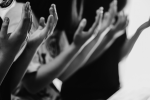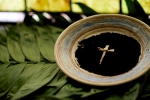July 2021
Music Ministry
Music That Builds Bridges
We all know the old expression, when you sing you pray twice. Well in my vision of music ministry, I add an additional thought – to do my best to live into the idea that what we sing has to do with the efficacy of our prayers. The sincerity of our prayers for building community and welcoming growth manifest themselves in the way we go about selecting music for our services.
Our challenge is to have music that authentically welcomes everyone.
The soul of the ministry is in the Word, and inclusive music is its ‘heartbeat.’
I feel that some part of the essence of the future of our Church lies in our ability to be authentically inclusive and to keep ourselves tuned in to that heartbeat.
Music is the universal language that reaches across generations and continents. So when we make the effort to be inclusive musically, we are praying the prayer that builds community and builds bridges.
Time, patience and an open heart
This thought is not a mandate for everyone to go out and prove themselves current by including music that doesn’t fit the scriptural theme for the day or the overall pulse of that particular worship community, but it is a mandate to explore those songs that go to the heart of what is moving and to include the ‘other’ (a term I dislike, but useful for projecting what some people feel in an unfamiliar worship setting.) This could include songs from many different sources. Then it is important to wrap the music inside the amazing liturgy of the church, placing it strategically, so that we can hear it in all its beauty.
Music placed in the course of worship with such care enhances our joy, our reflection, our prayer, our sense of hope. And it builds community in a way that is visceral, creating bonds and authentic connections.
There is no formula for this kind of work, except that we are driven by an open heart and love of the process. It takes time and lots of patience. Real progress in this way, however, begins with putting value on diverse cultural traditions and honoring the way the music is presented.
Presentation matters
I want to make certain to say that traditional music is an integral part of this ‘heartbeat.’ There are so many hymns and choral works that move us because they are beautiful. We’ve heard them as children and adults, and their spirit moves us in our solar plexus. Music can remind us of our loved ones, milestones and difficult times. These songs can lift us all up. But I do believe that how we present traditional hymns in worship is important. It is crucial to keep the energy and love of the music in the presentation, to relate musically to the story told in hymns and to sing the old hymns with love and with energy. It is also important, to do the educational homework and help all understand the history behind the traditional music we sing.
For example, the story I love to tell groups has to do with my trip to Leipzig and St. Thomas Church, where Bach was the “Thomaskantor” (Cantor at Saint Thomas). In that space, I got a sense of a kind of simplicity — of a man who was writing to glorify and uplift through his music while having children and living life. I think the soul of his music can be reached through the simple beauty of his music. He was by nature inclusive, and the heart of his music is inclusive.
In our more community-based settings, singing Bach can require lots of hands-on work, including selecting pieces that are accessible and a good match for the skill level of the choral group.
Learning this ‘heartbeat’ from others
Early on, I was influenced by several amazing musicians who loved music because it moved people. There was only good music and music that was not well done. Then, as I worked at Saint Mark’s, I encountered Horace Boyer, Editor of Lift Every Voice and Sing, Carl Maultsby, and the Rev Dr. Claire Mc Pherson, who have always had a lot to say about this subject and who lived into being musically inclusive. They all shared the belief that the concept of inclusivity is indeed the ‘heartbeat’ of the Church.
My mother, Adrienne Otis, was an accountant and a ‘full-time’ volunteer musician, organizing events that included C.L. Franklin and his church, as well as community choirs that sang Beethoven’s Ninth, Bach chorales, and spiritual classics from H.T. Burleigh and Hall Johnson. That was an amazing journey for those from the African American Episcopal and African American Episcopal Zion Church traditions. Owen Jander at Wellesley College, Ms. Ivy, who played gospel music like she was the accompanist to Mahalia, and William Mann, a brilliant organist I knew in Detroit, all brought their love of inclusive music to my life.
Owen Jander loved Marion Anderson and Leontyne Price. This was not the usual at Wellesley College, but it became so under his leadership. Ms. Ivy was a master at serving as accompanist in any style. Then there was Mr. Mann. He could play anything on the organ. We will never hear of him, because his day job was as a postman. He could play the organ and make people cry, and then play an up-tempo song that would make those listening want to shout – although there was not much shouting in my church growing up. When I worked with him as a child, he would point to his ear, and say,” Listen. Watch the music, but listen.”
This diverse group of amazing musicians loved being eclectic, just by the nature of who they were. And they all believed that the soul of what we do as music ministers lives in our desire to be inclusive and to inspire the best in all.
I bring up these people to point out my belief in the crucial importance that inspiring communities to reach out to one another and ‘others’ through music has for the life of the Church. There is no set formula. The actual ‘doing’ process is the glue. We need the term ‘other’ in discussion to dissolve. Although we always pray that the product is wonderful, it is the process that binds us. And so that process can become similar to walking a labyrinth, each step bringing us closer to understanding one another in our prayer as we make music in worship together.
This original prayer by Larry Marshall inspires my work:
It is comforting to know that when it was proclaimed that I was made in your image
That it’s the Soul and not the body that was meant
It’s comforting to know that when I talk to myself, I’m talking to YOU
When I talk to someone else that I’m talking to YOU
It’s comforting to know that because of this I am never without YOU
THEREFORE
I am never alone as I wander through this wonderment called LIFE
Wrapped in the comfort of YOUR love
Jeannine Otis is a performer, writer, recording artist, teaching artist and Music Director who made her professional performance debut at the age of 13 with the Detroit Symphony Orchestra under the direction of Carmen Dragon and with American Youth Performs as a soloist. Ms. Otis works with projects all over the world using art as a tool for social change and building community. Her book, The Gathering, has been turned into a music theater piece entitled “Who Am I” and featuring Anthony Turner. It has been presented in many settings, including the National Portrait Gallery in the Smithsonian in 2019. She is an honors graduate of both Wellesley College and Emerson College and is the Director of Music at Saint Marks Church in the Bowery.
Some examples of bridge- and community-building music
"Todo" by Sandra Montes, " I Am Sending You Light," Ana Hernandez
Traditional, “O God Our Help in Ages Past” (reminds me of my mother and her love of hymns)
LEVAS, “There’s a Sweet, Sweet Spirit in This Place” (sat with the late Horace Boyer, editor of LEVAS, as he played the hymn and explained what it meant to him; such an amazing moment – we also danced the 'bus stop' together at Kanuga)
Wonder, Love, and Praise, “Peace Before Us” (people have movements that go with this song.)
Taize. “Nada Te Turbe,” (We had a gathering with the leaders of the Taize Community in the early 90s, and I remember the feeling I got when I saw the icon and the many people who came to sing)
Song of Praise, “Come Let Us Worship the Lord in the Beauty of Holiness” (reminds me of Bill Randolph and our choir together)
Resources:
- The Message of Welcome, by Linda Buskirk, an ECF Vital Practices blog, February 10, 2020
- Risking Authenticity, by Lauren Kay, an ECF Vital Practices blog, June 4, 2019
- Pronoun Buttons: A Sign of Welcome, by Lisa G. Fischbeck, an ECF Vital Practices blog, April 5, 2019
- Ten Signs of a Welcoming Congregation, by Sandra T. Montes, Vestry Papers, November 2018






